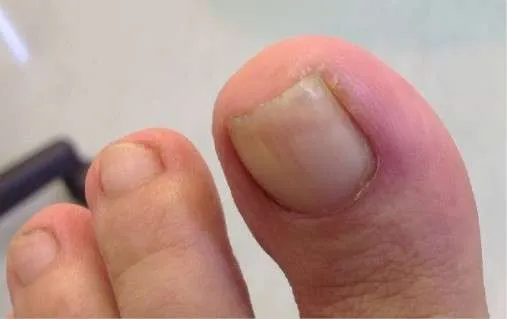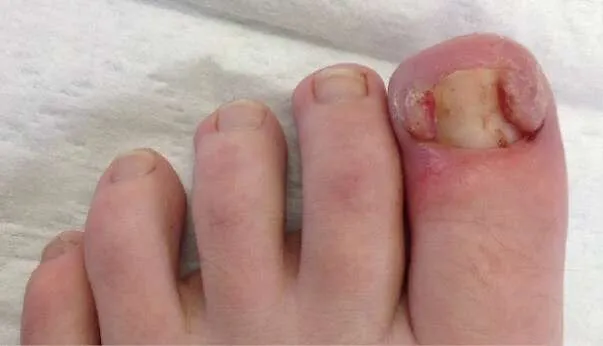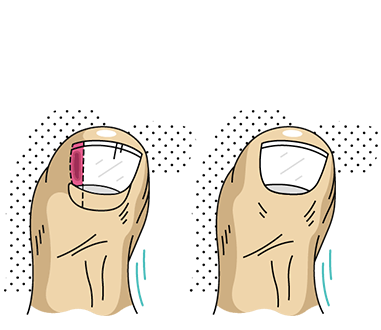Nail avulsion is an effective for ingrown toenails and allows quick resolution in symptoms.
Despite its effectiveness, if you are predisposed to ingrown toenails there is high risk it will reoccur.
Ingrown toenails occur when the corner or side of the toenail grows into the surrounding flesh, causing pain, discomfort, inflammation and sometimes infection. Although a minor discomfort at first, the problem can continue until it is infected and a serious reoccurring problem.
Luckily at The Foot Hub, we’re experts in managing and treating ingrown toenails. We regularly treat ingrown toenail symptoms and can provide a variety of conservative and surgical treatment options. The Foot Hub is here to treat the issues you face with an ingrown toenail in Sydney as your one-stop shop for all ingrown toenail treatment.
There are many ways to treat an ingrown toenail. The treatment we recommend will depend on the severity of the ingrown toenail, whether infection is present and what your previous treatments have been.
The Foot Hub recommends seeing a Podiatrist immediately if:
The Foot Hub begins our treatment process with a careful assessment to understand the state of your ingrown toenail. We will take your full medical history and recommend the best possible ingrown toenail treatment plan for you.
The best way to prevent an infected ingrown toenail is with a good regime of routine foot care. This treatment can also help to resolve the early stages of an ingrown toenail before it becomes more serious, and are especially useful for paediatric patients. Come and visit us and your podiatrist can professionally trim your toenails and clear the nail fold, addressing any underlying pathologies like fungal toenail infections.
Depending on the patient, we recommend a review once every two to six months depending on severity.
Ingrown toenail symptoms can occur at any age, and can become serious enough to affect daily activities like school, play and sports. Studies have shown that different ingrown toenail treatments have varying efficacies depending on several factors:

Daily foot soaking for at least 10 minutes. Applying topical antibiotics and using a good podiatric care routine. Good toenail trimming education. Lifting the corner of nails using dental floss or tape. Avoiding wearing tight-fitting footwear. If there is overlapping skin beginning to grow over the ingrown nail site (known as granulation tissue), silver nitrate can be effective, applied by the experts at The Foot Hub. These treatments can take 4 to 10 weeks to resolve the problem.

More invasive treatment is required and nail avulsion is recommended. If the patient has been suffering from multiple reoccurrences or needs a solution to the issue more quickly, then nail avulsion may be required as the most effective ingrown toenail treatment. Nail avulsion often includes a local anaesthetic and is quick and pain free.
Nail avulsion is considered an emergency ingrown toenail treatment at The Foot Hub. When patients have no history of ingrown toenails and need urgent care for severe symptoms, this treatment may be advised. This is normally a one-off treatment and gives relief from the symptoms in the short to medium term.
The procedure involves trimming the offending ingrown nail, cleaning the side of the toenail and removing any overlapping skin. In cases where the nail has begun to pierce the surrounding skin, the nail edge will need to be removed to allow the area to drain, reduce the swelling and heal.
There are two different types of nail avulsion:
PNA is normally performed for early stage ingrown toenails, where the nail is beginning to pierce the surrounding skin. TNA is normally indicated for toenail trauma or damage, and where the ingrown toenail has become more severely infected, and signs of cellulitis (a bacterial skin infection) are present on both sides of the nail.
Nail avulsion is a quick and effective ingrown toenail treatment, allowing for a rapid improvement in the patient’s symptoms. However, if you are predisposed to ingrown toenails, it’s likely that the problem may recur.


Nail avulsion is an effective for ingrown toenails and allows quick resolution in symptoms.
Despite its effectiveness, if you are predisposed to ingrown toenails there is high risk it will reoccur.
At The Foot Hub, we love to take care of our patients – so our procedures are as minimally painful as possible. Depending on the severity of the ingrown toenail, a local anaesthetic may be used to decrease discomfort during the procedure. In cases where the nail is very senstive to pressure and too painful to touch, a local anaesthetic is advised. This will allow us to do a thorough job of cleaning and clearing the nail and nail bed, so you can get back to your normal life as quickly as possible.
There are plenty of people who don’t like needles, and we offer needle-less injections with the Comfort Injection Technique. You can have a pain-free ingrown toenail surgery without any of the fear or nerves.
At The Foot Hub we understand that some people don’t like needles and have the option of needless injections. That’s right, you can have your ingrown toenail treatment without having an injection.
Comfort-in ™ is a spring-operated needle-free injection system. This system is a type of medical injecting syringe that uses high pressure – it uses the narrow jet of the injected liquid instead of a hypodermic needle to penetrate the epidermis (skin). With this we can deliver needleless local anaesthetic to the toe and be able to perform ingrown toenail treatment.

After your ingrown toenail treatment, your podiatrist will apply the first dressing on the toe/s, and you’ll be given the following instructions:
With The Foot Hub, recovery is quick and easy, you can expect the following:




Once the ingrown toenail section and any overlapping skin is removed, oral antibiotics are not normally required.
In the case of an obvious sign of infection (e.g. inflammation, pus, redness, extending cellulitis beyond the nail fold) then antibiotics may be prescribed. If you have a more severely infected ingrown toenail, we recommend reviewing the infection with a GP for a course of antibiotics, before we carry out the ingrown toenail treatment.
If your ingrown toenail is recurrent you may need ingrown toenail surgery (Partial Nail Avulsion with phenolisation) where we remove a portion of the nail along with the underlying nail tissue. By applying a chemical (Phenol) at the nail root this procedure, in 98% of cases, permanently prevents the offending portion of toenail from growing again.
Topical antibiotic creams like Bactroban can be used to effectively treat your infected ingrown toenail. Careful trimming and soaking of the ingrown toenail can also help to reduce and resolve ingrown toenail symptoms, depending on how severe the issue is.
Yes, this can help – you should use dental floss to separate the toenail and the nail bed where they contact. The dental floss is inserted obliquely under the corner of the ingrown toenail and pushed down. Make sure to use clean dental floss and replace it often.
Red light treatments like PACT (Photodynamic Antimicrobial Therapy) can be useful in treating infected ingrown toenails. If a fungal infection is the cause of your infected ingrown toenail, PACT can kill the microorganisms and allow the nail to resume healthy growth.
Yes, it can be helpful – combine a quarter of a cup of apple cider vinegar with warm water, and soak the affected foot for up to 20 minutes daily. It is a simple way to treat an infected ingrown toenail.
Using a topical antibiotic and carefully trimming the toenails of your baby can help reduce the chance of ingrown toenails. If you are not sure what the best way to do this is, talk to us at The Foot Hub and your podiatrist can help you to look after your baby’s feet and talk about what causes ingrown toenails.
If the home treatments listed above are not helping the symptoms, and the ingrown toenail seems to be getting worse, it’s probably time to get in touch with a specialist. If you have an ingrown toenail in Sydney The Foot Hub is on hand to help. If after multiple oral antibiotic courses, your ingrown toenail reoccurs and doesn’t go away we can book in an assessment and explore the necessity of ingrown toenail surgery.
Some natural ways to reduce ingrown toenail issues include:
If you repeatedly suffer from an infected ingrown toenail, then surgical options might be the best solution for you. Partial nail avulsion with phenolisation is a quick and permanent solution to cure those ingrown toenail symptoms. If you have any doubts about how to treat an ingrown toenail, at The Foot Hub we can explore all options with you so you can make an informed decision.

Have an infected ingrown toenail and dont know what to do? The Foot Hub offers meticulous cost effective treatment options for ingrown toenails.